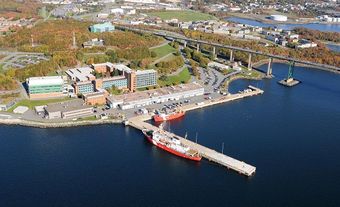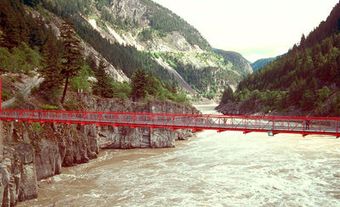
Conservation
Conservation can be defined as the planned and efficient use of natural RESOURCES for industrial and nonconsumptive purposes (eg, recreation, research) so as to ensure their permanence, productivity and diversity.
Conservation is a matter of trade-offs: deciding how much can be lost to achieve specific gains without losing productive potential and diversity of resources. Some see "conservation" as distinct from "preservation" - with preservationists intent on saving parcels of nature intact, free from any extractive use whatsoever - although historically the words were used interchangeably. Many people engaged in RESOURCE USE and management still equate conservation exclusively with preservation and environmentalism and feel that its proponents obstruct economic and social progress. While conservation may at times require unmodified preservation, it usually permits and sometimes requires carefully planned modifications. In fact, both sides have common interests: resource users and managers profit by maintaining resource productivity and a large number of options; and a sound economy, even if based on resource development, is essential if resource renewal, recycling and preservation programs are to be financed.
The modern concept of conservation has evolved since the beginning of the 20th century from simply slowing down the use of resources to managing resources for sustained yield with minimal waste, while recycling, controlling POLLUTION and maintaining the quality of the ENVIRONMENT. Early conservation activities in Canada, focused largely among the forestry community, were begun in the late 19th century, when the national economy was largely based on natural resources.
Economic growth has long been the objective of escalating industrial activity. The resulting wasteful energy use, diminution of high-grade resources and pollution of land, air and water have led to the questioning of the desirability of high levels of economic and population growth. People have begun to realize that maximum resource use for maximum economic gain is incompatible with society's long-term objectives. The idea that resource use for sustainable economic gain permits wider social benefits has gained broader acceptance (seeSUSTAINABLE DEVELOPMENT).
The desirability of socioeconomic rather than purely economic goals is the subject of considerable debate, and there is a trend toward viewing resources as borrowed from future generations rather than as inherited from the past. Thus, support has grown for ECOLOGICAL RESERVES, restoration of endangered species and habitats, and careful environmental planning before new industrial developments.
Geographic Factors
Various factors, including the diversity of rock formations, soils, climate, wildlife, vegetation and people, present special conservation problems. Canada's land area is vast, its human population relatively small, and people with limited funds can do relatively little to preserve and manage extensive resources. Canada encompasses an area of 9.98 million km2 and has the longest coastline (202 080 km including major island coastlines) in the world. The land ascends from sea level on the shores of the Pacific, Atlantic and Arctic OCEANS to MOUNTAINS as high as 5959 m in the CORDILLERA.
The huge northern plains, east of the Cordillera, contain fertile agricultural soils and immense energy reserves in the form of coal and PETROLEUM resources. The CANADIAN SHIELD, a mass of mineral-rich Precambrian rocks, forms the core of central Canada, and glaciation has moulded the landforms over large areas. The climate of Canada varies from harshly continental (cold dry winters, hot summers) to mildly oceanic; winter temperatures can be below -40°C, summer days 35°C or more.
Average annual temperatures range from -19ºC to -10ºC in the Arctic Archipelago to 10ºC in southwestern BC. Greater than 42% of Canada's land surface is covered by forests, 29% by tundra, 10% by peatland, and about 5% by grassland, each with its own type of wildlife. After Brazil and Russia, Canada has the largest amount of renewable water resources in the form of runoff and streamflow (on average, 3435 km3 per year, which is nearly enough to fill an empty Lake Huron). Of the total land area in Canada, 11.7% is water but only 3% is located where people live. The nation's resources extend onto the Continental Shelf, which is known to contain considerable quantities of minerals and oil and natural gas. The lakes, rivers and oceans also contain fish and mammals of considerable economic importance.
Renewable versus Nonrenewable
Renewable and nonrenewable resources require different conservation approaches. To enable society to use rather than consume resources, ECOSYSTEMS such as forests, tundra and grasslands must be maintained. Such maintenance involves management of the genetic base (vegetation, animals) and the environment (water, air, light, soil) to preserve productivity, genetic diversity and renewal processes.
Conservation of nonrenewable resources (eg, minerals, fossil fuels) requires development of policies to avoid waste (eg, by oil spills, gas flaring), to promote wise use and encourage recycling, to minimize adverse effects of mineral extraction on renewable resources and to develop renewable substitutes.
Uses of renewable and nonrenewable resources are interdependent; neither can be exploited or managed in complete isolation. Excessive use ("mining") of renewable resources may transform them into unrenewable losses, as when forest depletion leads to desert formation or an animal species is hunted to extinction, such as happened to the PASSENGER PIGEON and GREAT AUK.
History of Conservation
It is difficult to cite a beginning of conservation in Canada. First Nations peoples possessed spiritual beliefs that, whether deliberately environmental or not, restrained their exploitation of nature. Early European settlers enacted localized game laws designed to protect bird and wildlife species from overhunting. But there was a general, well-established belief in North America in the "myth of superabundance": that resources were so vast as to be inexhaustible.
The late 19th century saw the emergence of what has been called "the first conservation movement." This movement has been linked to a growing trust in scientific management and a shift in control of resources from rural people to urban elites. The 1882 American Forestry Congress in Montreal, which brought together university-trained foresters and industry leaders to discuss forest conservation, supported forest protection through fire suppression, the creation of reserves for forestry (not reserves from forestry) and other measures which tended to favour large industrial interests more than small woodlot operators. A similar trend can be seen in WILDLIFE CONSERVATION, with urban people who saw wildlife in sporting terms creating restrictive hunting seasons and expensive licenses, while rural inhabitants who relied upon wildlife for subsistence or livelihood were obliged to conform.
The birth of the Canadian NATIONAL PARKS system may be seen as another offshoot of conservationist thinking. The federal government created BANFF NATIONAL PARK in 1885 not because of sentimental or environmental concern, but simply to make the best economic use of it, since the Rockies were deemed unsuitable for much of anything but tourism. However, underlying this was an assumption that parks would become popular, for society was increasingly turning to nature in this period for reasons that cannot be considered economic.
The high-water mark of early conservationism came in 1909 with the creation of the federal COMMISSION OF CONSERVATION. This was an advisory body composed of academics, federal and provincial government ministers, and other interested parties, with the sweeping mandate to consider and improve upon the utilization of all Canadian natural resources. The commission played an important role in the passage of the 1917 US-Canada Migratory Birds Convention Act, but perhaps its greatest legacy is its publication of some 200 reports, which improved knowledge of the environment and aided in the formulation of public policy for decades. However, the resource-intensive economic boom that followed the First World War led to the commission's demise.
Private interests kept the spirit of conservation alive in the decades that followed. The HUDSON'S BAY COMPANY operated a series of nature reserves that depended upon local peoples, in particular First Nations. Jack MINER, described as "Canada's first celebrity conservationist," became known for his work banding birds on his family homestead in Kingsville, Ont, and grew into an advocate for the creation of BIRD SANCTUARIES and protective legislation. Nongovernmental conservation organizations also began to emerge. The Federation of Ontario Naturalists (now Ontario Nature) was established in 1931 to preserve wildlands for their intrinsic value. And DUCKS UNLIMITED CANADA, established in 1938 in tandem with a sister American organization, represented the interests of hunters who required the preservation of wetlands.
In the 1960s and 1970s, issues ranging from nuclear fallout to overcrowding in parks led to rising societal concern as to whether nature could accommodate humans' unrestrained use of it. While some have called this period "the second conservation movement," for many the term "conservation" now seemed too utilitarian - the more scientific "ecology" and then the more comprehensive "environmental" gained prominence.
A rash of new nature-minded organizations sprang up. The rapid disappearance of natural spaces led to the 1962 creation of the Nature Conservancy of Canada, focused on protecting ecologically-significant land first in southern Ontario and then throughout Canada. The National and Provincial Parks Association of Canada organized in 1963 to counteract the pressure of commercial development within wilderness parks; it has since evolved into the Canadian Parks and Wilderness Society, intent on preserving one-half of the country's public land forever wild for the public trust. Canadians also created national offshoots of American and global conservation groups. The WORLD WILDLIFE FUND CANADA, an offshoot of the international organization, was founded in 1967. The Sierra Club opened provincial offices in British Columbia and Ontario in the late 1960s, and established national operations in 1989.
Demographic Factors
The population of Canada has doubled since 1960, which has made the nation's people more aware of the degradation of its natural resources and the alarming long-term consequences of this continuing process. The need to conserve resources and develop conservation policies involving ecological, economic, social, ethical, political and legal factors has become increasingly apparent.
Canada's great regional disparity in economic development tends to focus attention on the short-term solution of economic problems rather than on the long-term consequences of resource use; hence, resource exploitation often takes priority over wise management and preservation (seeREGIONAL ECONOMICS).
Human Factors
Human activities are responsible for many conservation problems, although natural disturbances also have considerable impact. Technological innovations allow increasingly rapid and efficient harvesting of forests, agricultural crops, wildlife and fish. In forestry, chain saws, mechanical harvesters and on-site tree chippers allow the quick and efficient harvest of huge numbers of trees, including stems, branches and leaves.
Forest renewal technology has developed much less rapidly. Forest-harvesting activities, forest fires, unsuccessful farming attempts and inadequate reforestation have resulted in a backlog of millions of hectares of forest land that has failed to regenerate with commercially useful trees.
Heavy harvesting and processing equipment has been developed for the proposed extraction of energy from Canada's peatlands, placing one of the world's major reserves of carbon under threat. Canada's natural grasslands have been nearly depleted through plowing for agriculture.
The development of electronic equipment for locating fish shoals has made fishing more efficient, and the pollution of freshwater lakes by industry has led to serious problems of eutrophication, thereby reducing fish populations and recreational values (seeWATER POLLUTION). In spite of attempts to restock lakes and rivers, overfishing in many accessible areas has reduced fish populations.
Wildlife remains an important food source for some of Canada's Indigenous peoples, and provides recreation for hunters, as well as considerable revenues. In many cases, wildlife populations are seriously threatened by habitat destruction and by easier access to remote areas by snow vehicles and helicopters. Large mammals and sensitive species are particularly vulnerable. Migratory herds of CARIBOU in northern Canada are threatened by increasing industrial activity in their main habitats and along migration routes. Disturbance by visitors to bird colonies may inadvertently reduce nesting success.
Human activities have conversely also provided new habitats, enabling some species to expand into areas where they were formerly scarce or absent. Extensive monoculture cropping practices have resulted in increases of some species (eg, red-winged blackbird) to the extent that they become pests, but have caused a marked decrease in species diversity. Exotic wildlife, vegetation and insects have been introduced to Canada. Some have been harmless or possibly beneficial, but many have had disastrous effects (eg, emerald ash borer or Asian carp).
SOIL CONSERVATION, the maintenance of soil stability and fertility, is vital if water quality and food, wood, fibre and other crops are to be sustained for future generations. The massive soil erosion and desert formation in farmlands of western North America in the 1930s illustrate the consequence of inadequate soil management (seeDROUGHT; GREAT DEPRESSION). Intensive agricultural practices led to widespread reduction of vital organic matter in agricultural soils. Large areas of fertile agricultural soils continue to be destroyed each year by expansion of cities onto productive farmland.
Soil stability has long been impaired in some areas (eg, mountainous areas of BC) by forest harvesting, forest road construction and slash burning, but provincial agencies responsible for the management of natural resources are now paying increased attention to environmental concerns. Delays in replacing trees after harvesting result in heavy losses of soil nitrogen caused by the accelerated mineralization of soil organic matter. The trend toward using high-yielding tree species and shorter rotations involves an inherent risk of accelerating nutrient removal and reducing soil fertility.
Considerable proportions of high-grade mineral ores and readily accessible fossil fuels, particularly oil, have been consumed since the mid 1900s to meet the increasing demands of an industrial society and exports. Consequently, industry must now rely on lower-grade or relatively inaccessible mineral and fossil-fuel resources which are costly to locate, extract, transport and process.
Legislation and Political Activity
Canada's federal structure, with its national, provincial and municipal levels of government, make the creation and implementation of environmental legislation complex (seeENVIRONMENTAL LAW). Provincial governments are responsible for the use and management of many of Canada's natural resources, so conservation measures often vary from province to province. However, some national standards have been established by legislation such as the Canadian Environmental Protection Act and the Canadian Environmental Assessment Act. The federal government is also responsible for national parks and for the management and use of large areas of land in the 3 territories, as well as international aspects of pollution control, migratory birds, and the import and export of plants and wildlife.
Conservation priorities in Canada have developed in the context of an industrialized nation with a rapidly expanding, mainly urban population of now over 34 million people. Heavy and often conflicting demands are being made on the nation's vast but limited resources. Conservation provides a philosophical and conceptual framework within which resources can be allocated in a manner in keeping with the needs, aspirations and advances of society.
See alsoENVIRONMENTAL AND CONSERVATION MOVEMENTS; ENVIRONMENTAL IMPACT ASSESSMENT; ENVIRONMENTAL MANAGEMENT; RESOURCE MANAGEMENT; STRATEGIC ENVIRONMENTAL ASSESSMENT.

 Share on Facebook
Share on Facebook Share on X
Share on X Share by Email
Share by Email Share on Google Classroom
Share on Google Classroom


